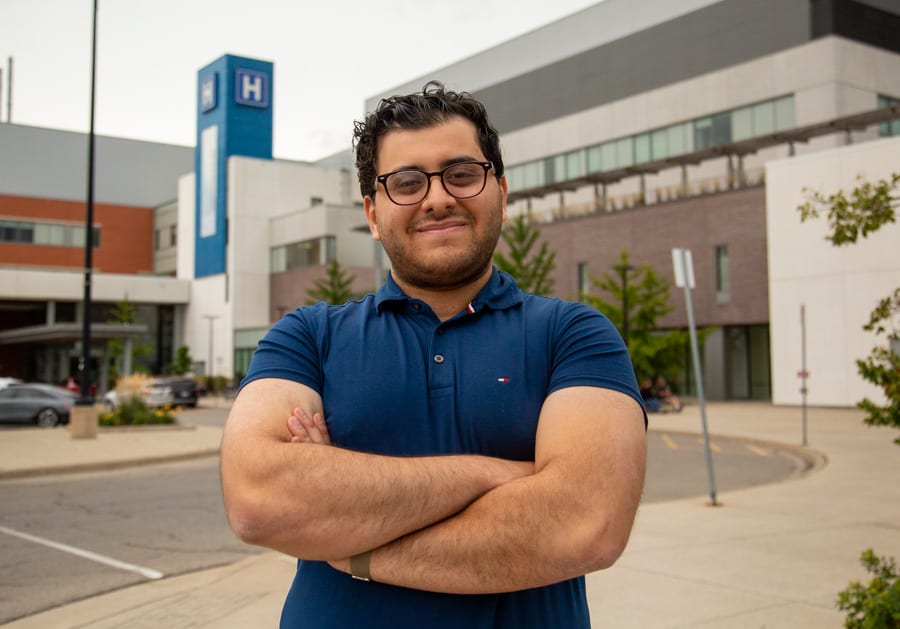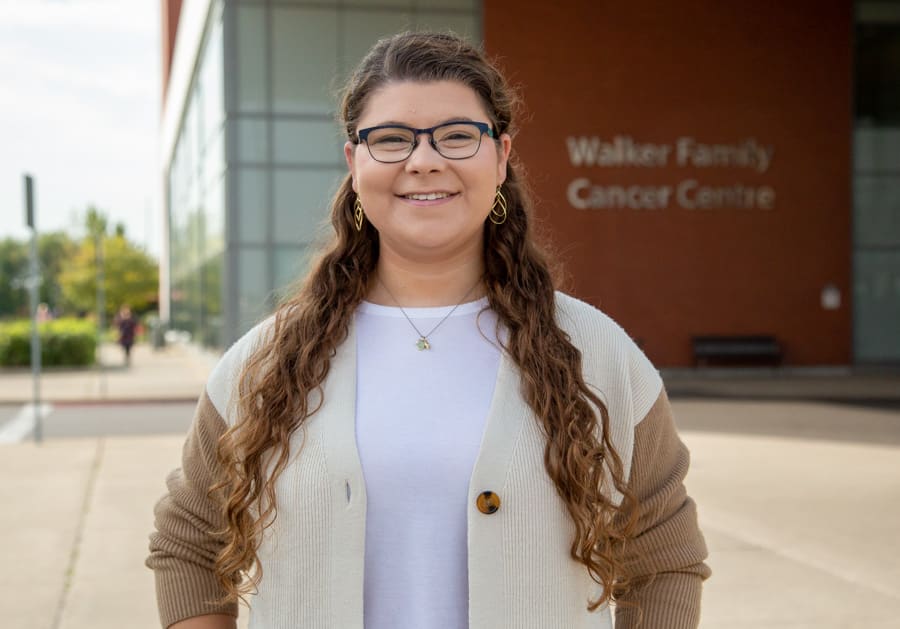Amr Almasri had making ratatouille and starting medical school on his list of feats to accomplish.
He checked both those boxes this past summer.
Keira Parr also had training to become a doctor on her to-do list. It’s something she’s been working toward for the past several years, doing translational research related to oncology throughout her master’s degree before taking a seat in a med school classroom in August.
Almasri and Parr are just two of 32 new medical learners beginning their studies at McMaster University’s Michael G. DeGroote School of Medicine – Niagara Regional Campus (NRC) this term.
Their paths to medical school didn’t follow the typical route. But the experiences they’ve gained along the way have set them up to make their marks on healthcare, other medical learners, and a foodie or two before they graduate in 2027.
These are their stories.

Amr Almasri hopes to become a physician for a sports team or a plastic surgeon.
Amr Almasri
On any given day, you might spot Amr Almasri carrying a container of brownies.
The Mississauga resident often bakes after class at NRC to unwind and he likes to share the results with his classmates. After all, making friends with salad remains questionable, but carbs? They can be the gateway to many important relationships.
“Food is a universal language,” Almasri says. “Even if you’ve never met someone before, food is an instant way to connect.”
"When you’ve worked for something for five or six years and to finally be here, it’s surreal."
Almasri is all about connection. It’s a skill that will come in handy as he works toward becoming a doctor for a professional sports team or as a plastic surgeon helping people rebuild their lives after significant physical trauma.
Almasri learned early on the importance of connecting with people to adapt to new situations.
He was born in Syria but his family moved to Dubai when he was just one so his dad could grow his computer startup. The family relocated to Ottawa 13 years later as Almasri started high school. They settled two years later in Mississauga, which has been home for the family ever since.
Each move taught Almasri how to make friends fast.
“I’m an introvert but moving around forces you out of your comfort zone and talking to people,” Almasri says. “That will be helpful when working with patients because it’s getting to know someone as quickly as you can.”
Initially, his dad hoped he would join the family business but Almasri knew medicine was his real calling. He began his journey at the University of Saskatchewan where he earned his bachelor of kinesiology and worked as an athletic trainer with the Huskies varsity hockey team.
“I loved being part of a team,” he recalls. “I didn’t play any sports growing up but in about two months I learned everything about hockey. It was a great experience and shaped what I wanted to do in medicine.”
After graduating, he took extra courses at the University of Alberta to boost his chances of getting into medical school. In between his studies, he took breaks in the kitchen, posting his culinary feats to his Instagram account @mydiamondkitchen, including an intricate ratatouille tian inspired by the eponymous Disney movie.
To help other aspiring medical learners, he recently launched an AI-based tool called CasPrep.net that med school hopefuls can use to prepare for the Casper exam, which he says weighs heavily in admissions to McMaster and other Canadian medical schools.
“Many of my friends, including myself, whose first language isn’t English, struggled with such a test,” he says. “And when I was preparing for it, there weren’t many affordable or good resources to help. So I took things into my own hands.”
But he credits others, more than his own individual efforts or any baked goods, for getting into medical school at all. Both his parents made sacrifices so he could be here, he says. He’s also received incredible support from his community.
“I really hope to repay that in the future,” Almasri says. “I still don’t believe I got into med school. When you’ve worked for something for five or six years and to finally be here, it’s surreal.”

Keira Parr has ambitions of becoming an oncologist or surgeon.
Keira Parr
Keira Parr has only good things to say about her family physician. Ditto for her dentist and her chiropractor.
In addition to providing stellar care to Parr throughout her life, they also had a profound influence as women practitioners on their young patient. They became Parr’s professional role models, sparking her dream to one day practise medicine.
“I had all female doctors growing up,” Parr says. “All the doctors I’ve had have taken a keen interest in my life when they didn’t have to. It wasn’t just about my symptoms and health. Of course, they care about that but they care about more than that.”
“His biggest philosophy was that you don’t need to follow the classic pathway to medicine. You can do anything you’re interested in. The happiness will follow, the grades will follow and you’ll be able to get there."
Although those positive interactions helped set Parr on a career path, getting into medical school didn’t follow the usual trajectory. She considered health sciences as her first stepping stone to get her there after high school. But after meeting Prof. David Ellis in the medical professional stream at Trent University, she was inspired to follow her curiosity and enrolled in forensic biology instead.
“His biggest philosophy was that you don’t need to follow the classic pathway to medicine. You can do anything you’re interested in. The happiness will follow, the grades will follow and you’ll be able to get there,” Parr recalls.
It was one of her best decisions. The classes were small. She got to know her professors and classmates. She developed strong research and record-keeping skills, and honed her attention to detail. Parr felt ready to apply to medical school after graduating.
Then fate nudged her in a different direction. She pursued her master’s degree in anatomical sciences at Queen’s University where Parr was one of 13 students in the intensive, close-knit program that gave her space to make her mark.
It was her first time working with a donor, allowing Parr to really delve into the inner workings of the human body and develop a profound respect for those who give their body to science when they die.
“The opportunity to work with a donor completely changed my view of who we are and what we do as humans,” Parr says. “Working with donors is not something I would change for the world. I learned so much from them.”
She shared some of that knowledge as first author on an anatomical case study manuscript, “A case of significant loss of mesenteric fat: Educational and clinical relevance,” published in June in the journal Morphologie.
Parr has no regrets about her route to medical school. Her master’s degree gave her the chance to teach, too, clarifying for her that she would love to devote her career, perhaps as an oncologist or surgeon, as much to her patients as to furthering best practice through research, and passing on that knowledge in a classroom.
And maybe along the way inspiring a young patient to one day become a compassionate healthcare provider, just as Parr’s own doctors influenced her.
“Of course, getting into medical school a couple years earlier would have been great, but I don’t think the timeline matters,” Parr says. “I’ve had so many positive experiences that have shaped me for the better as a person, an academic and a future physician.”

